Kia Sorento 2015 Owner's Manual

Kia, THE COMPANY
Thank you for becoming the owner of a new Kia vehicle.
As a global vehicle manufacturer focused on building high-qual- ity, value for money prices, Kia Motors is dedicated to providing you with a customer service experience that exceeds your expectations.
All information contained in this Owner’s Manual is accurate at the time of publication. However, Kia reserves the right to make changes at any time so that our policy of continual product improvement can be carried out.
This manual applies to all Kia models and includes descriptions and explanations of optional as well as standard equipment. As a result, you may encounter material in this manual that is not applicable to your specific Kia vehicle.
Drive safely and enjoy your Kia! 

 Foreword
Foreword
Thank you for choosing a Kia vehicle.
When you require service, remember that your Kia Dealer knows your vehicle best. Your dealer has factory-trained technicians, recommended special tools, genuine Kia replacement parts and is dedicated to your complete satisfaction. Because subsequent owners require this important information as well, this publication should remain with the vehicle if it is sold. This manual will familiarize you with operational, maintenance and safety information about your new vehicle. It is supplemented by a Warranty and Consumer Information manual that provides important information on all warranties regarding your vehicle. We urge you to read these publications carefully and follow the recommendations to help assure enjoyable and safe operation of your new vehicle.
Kia offers a great variety of options, components and features for its various models. Therefore, some of the equipment described in this manual, along with the various illustrations, may not be applicable to your particular vehicle. The information and specifications provided in this manual were accurate at the time of printing. Kia reserves the right to discontinue or change specifications or design at any time without notice and without incurring any obligation. If you have questions, always check with your Kia dealer.
We assure you of our continuing interest in your motoring pleasure and satisfaction in your Kia vehicle.
© 2013 Kia Canada Inc.
All rights reserved. Reproduction by any means, electronic or mechanical, including photocopying, recording, or by any information storage and retrieval system or translation in whole or part is not permitted without written authorization from Kia Canada Inc.
Printed in U. S. A.
i
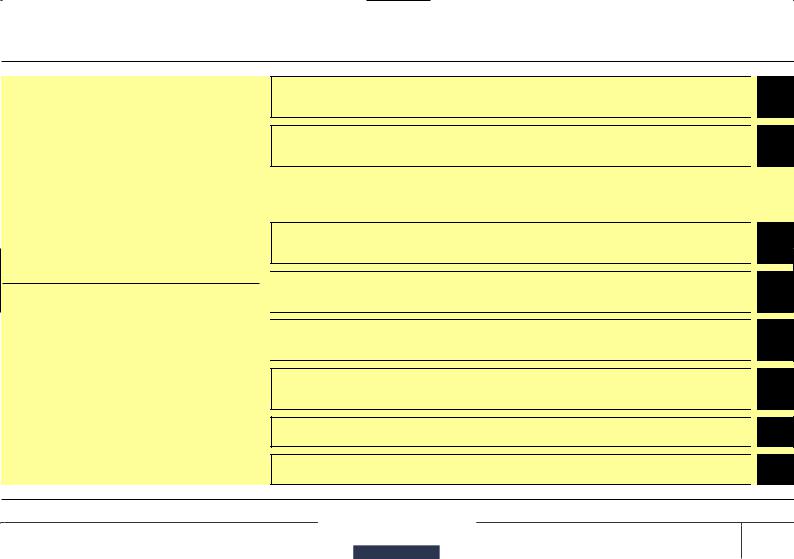
Introduction
How to use this manual / Fuel requirements / Vehicle break-in process / Vehicle handling instructions / Vehicle data collection and event data recorders
Your vehicle at a glance
Exterior overview / Interior overview / Instrument panel overview / Engine compartment

 1
1

 2
2
Safety features of your vehicle |
|
3 |
Seats / Seat belts / Child restraint system / Air bag |
|
|
|
|
|
Features of your vehicle
Keys / Door locks / Tailgate / Windows / Hood / Fuel filler lid / Panoramic sunroof / Steering wheel / Mirrors / Instrument cluster / Lighting / Wipers & Washers / Climate control system / Multimedia system / Etc.
table of contents |
|
|
|
Driving your vehicle |
|
|
|||
|
||||
|
|
|
|
|
|
|
|
|
Before driving / Engine start/stop button / Transaxle / All Wheel Drive (AWD) / Brake system / |
|
|
|
|
Cruise control system / Active ECO system / Winter driving / Vehicle load limit / Etc. |
|
|
|
|
What to do in an emergency |
|
|
|
|
|
|
|
|
|
Road warning / Emergency while driving / Emergency starting / Engine overheat / Flat tire / Towing / Etc. |
|
|
|
|
|

 4
4

 5
5

 6
6
Maintenance
Engine compartment / Maintenance service / Engine oil / Engine coolant / Brake fluid / Washer fluid / Parking brake / Air cleaner / Wiper blades / Battery / Tire and wheels / Fuses / Etc.
Specifications & Consumer information
Index

 7
7

 8
8

 I
I
ii

Introduction
. . . . . . . . . . . . . . . . . . . . . .How to use this manual |
1-2 |
1 |
Fuel requirements . . . . . . . . . . . . . . . . . . . . . . . . . . |
1-3 |
|
• Gasoline containing alcohol and methanol. . . . . . . . . 1-3
• Do not use methanol . . . . . . . . . . . . . . . . . . . . . . . . . . . 1-4
• Fuel Additives . . . . . . . . . . . . . . . . . . . . . . . . . . . . . . . . 1-4
• Operation in foreign countries. . . . . . . . . . . . . . . . . . . 1-4
Vehicle handling instructions . . . . . . . . . . . . . . . . . 1-5 Vehicle break-in process . . . . . . . . . . . . . . . . . . . . . 1-5

Introduction
HOW TO USE THIS MANUAL
We want to help you get the greatest possible driving pleasure from your vehicle. Your Owner’s Manual can assist you in many ways. We strongly recommend that you read the entire manual. In order to minimize the chance of death or injury, you must read the WARNING and CAUTION sections in the manual.
Illustrations complement the words in this manual to best explain how to enjoy your vehicle. By reading your manual, you will learn about features, important safety information, and driving tips under various road conditions.
The general layout of the manual is provided in the Table of Contents. Use the index when looking for a specific area or subject; it has an alphabetical listing of all information in your manual.
Sections: This manual has eight sections plus an index. Each section begins with a brief list of contents so you can tell at a glance if that section has the information you want.
You will find various WARNINGs, CAUTIONs, and NOTICEs in this manual. These WARNINGs were prepared to enhance your personal safety.You should carefully read and follow ALL procedures and recommendations provided in these WARNINGs, CAUTIONs and NOTICEs.
 WARNING
WARNING
A WARNING indicates a situation in which harm, serious bodily injury or death could result if the warning is ignored.
 CAUTION
CAUTION
A CAUTION indicates a situation in which damage to your vehicle could result if the caution is ignored.
NOTICE
A NOTICE indicates interesting or helpful information is being provided.
1 2
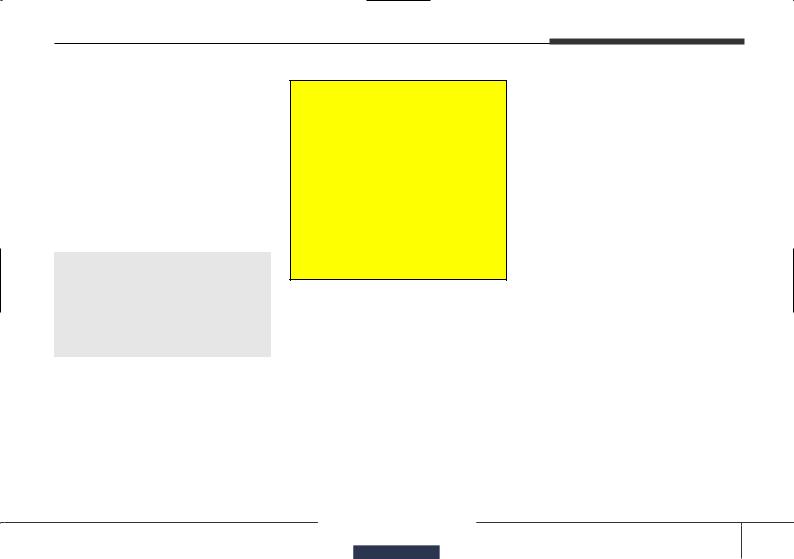
FUEL REQUIREMENTS
Your new vehicle is designed to use only unleaded fuel having a pump octane number ((R+M)/2) of 87 (Research Octane Number 91) or higher.
Your new vehicle is designed to obtain maximum performance with UNLEADED FUEL, as well as minimize exhaust emissions and spark plug fouling.
 CAUTION
CAUTION
Never add any fuel system cleaning agents to the fuel tank other than what has been specified. (Consult an authorized Kia dealer for details.)
 WARNING
WARNING
•Do not "top off" after the nozzle automatically shuts off when refueling.
•Tighten the cap until it clicks
one time, otherwise the Check Engine  light will illuminate.
light will illuminate.
•Always check that the fuel cap is installed securely to prevent fuel spillage, especially in the event of an accident.
Gasoline containing alcohol and methanol
Gasohol, a mixture of gasoline and ethanol (also known as grain alcohol), and gasoline or gasohol containing methanol (also known as wood alcohol) are being marketed along with or instead of leaded or unleaded gasoline.
Introduction
Pursuant to EPA regulations, ethanol may be used in your vehicle.
Do not use gasohol containing more than 10% ethanol, and do not use gasoline or gasohol containing any methanol. Ethanol provides less energy than gasoline and it attracts water, and it is thus likely to reduce your fuel efficiency and could lower your MPG results.
Methanol may cause drivability problems and damage to the fuel system.
Discontinue using gasohol of any kind if drivability problems occur.
Vehicle damage or drivability problems may not be covered by the manufacturer’s warranty if they result from the use of:
1.Gasoline or gasohol containing methanol.
2.Leaded fuel or leaded gasohol.
1 3

Introduction
"E85" fuel is an alternative fuel comprised of 85 percent ethanol and 15 percent gasoline, and is manufactured exclusively for use in Flexible Fuel Vehicles. “E85” is not compatible with your vehicle. Use of “E85” may result in poor engine performance and damage to your vehicle's engine and fuel system. Kia recommends that customers do not use fuel with an ethanol content exceeding 15%.
 CAUTION
CAUTION
Your New Vehicle Limited Warranty does not cover damage to the fuel system or any performance problems caused by the use of “E85” fuel.
 CAUTION
CAUTION
Never use gasohol which contains methanol. Discontinue use of any gasohol product which impairs drivability.
Use of MTBE
Kia recommends avoiding fuels containing MTBE (Methyl Tertiary Butyl Ether) over 15.0% vol. (Oxygen Content 2.7% weight) in your vehicle.
Fuel containing MTBE over 15.0% vol. (Oxygen Content 2.7% weight) may reduce vehicle performance and produce vapor lock or hard starting.
 CAUTION
CAUTION
Your New Vehicle Limited Warranty may not cover damage to the fuel system and any performance problems that are caused by the use of fuels containing methanol or fuels containing MTBE (Methyl Tertiary Butyl Ether) over 15.0% vol. (Oxygen Content 2.7% weight.)
Do not use methanol
Fuels containing methanol (wood alcohol) should not be used in your vehicle. This type of fuel can reduce vehicle performance and damage components of the fuel system.
Fuel Additives
Kia recommends that you use good quality gasolines treated with detergent additives such as TOP TIER Detergent Gasoline, which help prevent deposit formation in the engine. These gasolines will help the engine run cleaner and enhance performance of the Emission Control System. For more information on TOP TIER Detergent Gasoline, please go to the website (www.toptiergas.com)
For customers who do not use TOP TIER Detergent Gasoline regularly, and have problems starting or the engine does not run smoothly, additives that you can buy separately may be added to the gasoline.
If TOP TIER Detergent Gasoline is not available, one bottle of additive should be added to the fuel tank at every 7,500miles or every engine oil change is recommended. Additives are available from your authorized Kia dealer along with information on how to use them. Do not mix other additives.
1 4

Operation in foreign countries
If you are going to drive your vehicle in another country, be sure to:
•Observe all regulations regarding registration and insurance.
•Determine that acceptable fuel is available.
VEHICLE HANDLING
INSTRUCTIONS
As with other vehicles of this type, failure to operate this vehicle correctly may result in loss of control, an accident or vehicle rollover.
Specific design characteristics (higher ground clearance, track, etc.) give this vehicle a higher center of gravity than other types of vehicles. In other words they are not designed for cornering at the same speeds as conventional 2-wheel drive vehicles. Avoid sharp turns or abrupt maneuvers. Again, failure to operate this vehicle correctly may result in loss of control, an accident or vehicle rollover. Be sure to read the
“Reducing the risk of a rollover” driving guidelines, in section 5 of this manual.
Introduction
VEHICLE BREAK-IN
PROCESS
No special break-in period is needed. By following a few simple precautions for the first 1,000 km (600 miles) you may add to the performance, economy and life of your vehicle.
•Do not race the engine.
•While driving, keep your engine speed (rpm, or revolutions per minute) between 2,000 rpm and 4,000 rpm.
•Do not maintain a single speed for long periods of time, either fast or slow. Varying engine speed is needed to properly break-in the engine.
•Avoid hard stops, except in emergencies, to allow the brakes to seat properly.
•Don't let the engine idle longer than 3 minutes at one time.
•Don't tow a trailer during the first 2,000 km (1,200 miles) of operation.
1 5

Your vehicle at a glance
Exterior overview .I. . . . . . . . . . . . . . . . . . . . . . . . . . 2-2 InteriorExterioroverview .II. . . . . . . . . . . . . . . . . . . . . . . . . . 2-34 Instrumentteioroverviewpanel overview. . . . . . . . . . . . . . . . . . . . . . . . . . . 2-45
EngineInstrumentcompartmentnel overview. . . . . . . . . . . . . . . . . . . . . . . . 2-56 2 Engine compartment . . . . . . . . . . . . . . . . . . . . . . . . 2-6

Your vehicle at a glance
EXTERIOR OVERVIEW
Front view
1. Hood...................................................... |
4-38 |
2. Head lamp........................................... |
4-108 |
3. Fog lamp ............................................. |
4-112 |
4. Wheel and tire ....................................... |
7-50 |
5. Outside rearview mirror......................... |
4-64 |
6. Panorama sunroof................................. |
4-44 |
7. Front windshield wiper blades ............... |
7-44 |
8. Windows ................................................ |
4-33 |
The actual shape may differ from the illustration.
OXMA013001
2 2

Your vehicle at a glance
Rear view
9. Door locks ............................................. |
4-21 |
10. Fuel filler lid ......................................... |
4-40 |
11. Rear combination lamp |
|
12. High mounted stop lamp |
|
13. Rear window wiper blade .................... |
7-45 |
14. Tailgate ................................................ |
4-25 |
15. Antenna ............................................. |
4-159 |
16. Rearview camera .............................. |
4-106 |
17. Parking assist system ....................... |
4-102 |
The actual shape may differ from the illustration.
OXM013002L
2 3
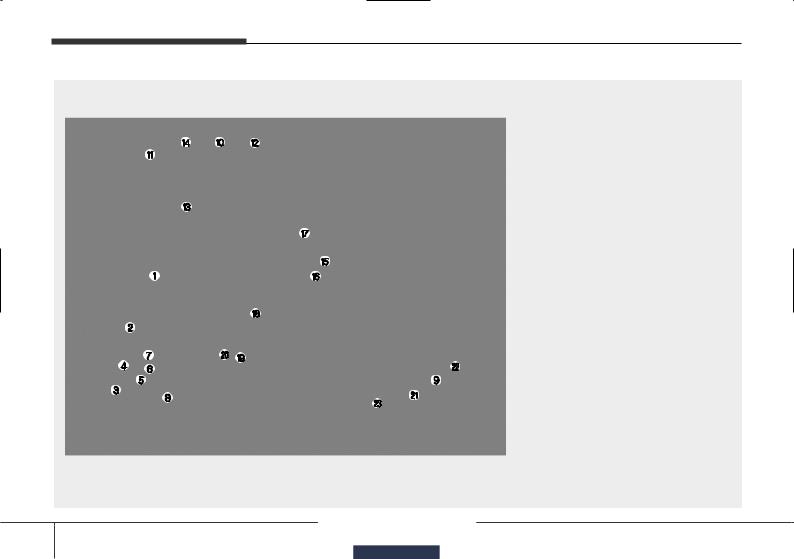
Your vehicle at a glance
INTERIOR OVERVIEW
1. Driver position memory system button ..... |
3-8 |
2. Inside door handle................................... |
4-22 |
3. Power window switch............................... |
4-33 |
4. Central door lock switch .......................... |
4-23 |
5. Power window lock button ....................... |
4-36 |
6. Outside rearview mirror control............... |
4-65 |
7. Outside rearview mirror folding ............... |
4-66 |
8. Fuel filler lid open switch ......................... |
4-40 |
9. Parking assist system On/Off button..... |
4-102 |
10. AWD Lock button................................... |
5-23 |
11. ESC Off button ...................................... |
5-36 |
12. Instrument panel illumination |
|
control switch ......................................... |
4-69 |
13. BSD On/OFF button .............................. |
5-49 |
14. Steering wheel....................................... |
4-49 |
15. Steering wheel warmer On/Off Button |
..4-51 |
16. Tilt and telescopic steering |
|
control lever ......................................... |
4-50 |
17. Lighting control lever............................ |
4-109 |
18. Inner panel fuse panel........................... |
7-65 |
19. Parking brake pedal............................... |
5-32 |
20. Hood release lever................................. |
4-38 |
21. AC inverter........................................... |
4-152 |
22. Active ECO ........................................... |
5-54 |
23. Seat.......................................................... |
3-2 |
The actual interior in the vehicle may differ from the illustration
OXMA013003N
2 4
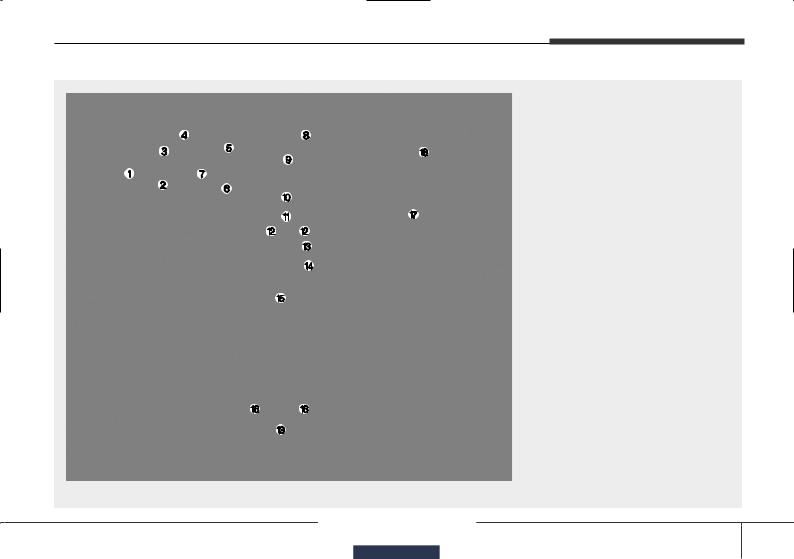
Your vehicle at a glance
INSTRUMENT PANEL OVERVIEW
1. |
Audio remote control buttons |
............ |
4-160 |
2. |
Driver’s front air bag ............................ |
|
3-60 |
3. Horn..................................................... |
|
4-51 |
|
4. |
Instrument cluster................................ |
|
4-68 |
5. Wiper and washer control lever......... |
4-113 |
||
6. |
Ignition switch or |
|
|
|
Engine start/stop button ................. |
|
5-5, 5-8 |
7. |
Cruise control button ........................... |
|
5-44 |
8. |
Digital clock ....................................... |
|
4-154 |
9. Audio ................................................. |
|
4-159 |
|
10. Hazard warning flasher ....................... |
|
6-2 |
|
11. Climate control system......... |
4 - 121, 4-131 |
||
12. Front seat warmer / |
|
|
|
|
Seat cooler............................... |
|
3-12, 3-14 |
13. Power outlet..................................... |
|
4-151 |
|
14. Cup holder....................................... |
|
4-149 |
|
15. Center console storage box ............ |
|
4-146 |
|
16. Rear seat warmer.............................. |
|
3-21 |
|
17. Glove box ........................................ |
|
4-146 |
|
18. Passenger’s front air bag .................. |
|
3-60 |
|
The actual instrument panel in the vehicle may differ from the illustration
OXM013004L
2 5

Your vehicle at a glance
ENGINE COMPARTMENT
■ Gasoline Engine (Theta II 2.4L) - GDI
1. |
Engine coolant reservoir................... |
7-34 |
2. |
Engine oil filler cap ........................... |
7-31 |
3. |
Brake/clutch fluid reservoir ............... |
7-36 |
4. |
Air cleaner......................................... |
7-39 |
5. Fuse box ........................................... |
7-64 |
|
6. |
Negative battery terminal.................. |
7-47 |
7. |
Positive battery terminal ................... |
7-47 |
■ Gasoline Engine (Lambda II 3.3L) - GDI |
Radiator cap |
7-35 |
8. |
||
9. |
Engine oil dipstick ............................. |
7-31 |
10. Windshield washer fluid reservoir ... |
7-37 |
|
The actual engine compartment in the vehicle may differ from the illustration.
ODMEMC2001/ONCEIN2007
2 6

Safety features of your vehicle
Seats . . . . . . . . . . . . . . . . . . . . . . . . . . . . . . . . . . . . . . 3-2
• Front seat adjustment - Manual . . . . . . . . . . . . . . . . . 3-5
• Front seat adjustment - Power. . . . . . . . . . . . . . . . . . . 3-6
• Seat warmer. . . . . . . . . . . . . . . . . . . . . . . . . . . . . . . . . 3-12
• Seat cooler . . . . . . . . . . . . . . . . . . . . . . . . . . . . . . . . . . 3-14
• Rear seat adjustment . . . . . . . . . . . . . . . . . . . . . . . . . 3-15
Seat belts . . . . . . . . . . . . . . . . . . . . . . . . . . . . . . . . . 3-25
• Seat belt restraint system . . . . . . . . . . . . . . . . . . . . . . 3-25
• Pre-tensioner seat belt. . . . . . . . . . . . . . . . . . . . . . . . . 3-31
• Seat belt precautions . . . . . . . . . . . . . . . . . . . . . . . . . . 3-34
• Care of seat belts . . . . . . . . . . . . . . . . . . . . . . . . . . . . . 3-37
Child restraint system . . . . . . . . . . . . . . . . . . . . . . 3-38
• Using a child restraint system . . . . . . . . . . . . . . . . . . 3-40
• Tether Anchor system . . . . . . . . . . . . . . . . . . . . . . . . . 3-43
• Securing a child restraint seat with
child seat lower anchor system . . . . . . . . . . . . . . . . 3-44
Air bag - supplemental restraint system . . . . . . . 3-47
• How does the air bag system operate . . . . . . . . . . . . 3-48
• Do not Installing a child restraint on a front passenger's seat . . . . . . . . . . . . . . . . . . . . . . . . . . . . . 3-50
• Air bag warning light . . . . . . . . . . . . . . . . . . . . . . . . . 3-50
• SRS components and functions . . . . . . . . . . . . . . . . . 3-51
• Occupant classification system. . . . . . . . . . . . . . . . . . 3-54
• Main components of occupant detection system . . . 3-55
• Driver's and passenger's front air bag . . . . . . . . . . . 3-60
• Side air bag . . . . . . . . . . . . . . . . . . . . . . . . . . . . . |
. . . . 3-66 |
|
• Curtain air bag . . . . . . . . . . . . . . . . . . . . . . . . . . |
. . . . 3-67 |
|
• Inflation and non-inflation conditions of |
|
|
the air bag . . . . . . . . . . . . . . . . . . . . . . . . . . . . . . . |
3-70, 3-72 |
|
• SRS Care . . . . . . . . . . . . . . . . . . . . . . . . . . . . . . . |
. . . . 3-74 |
|
• Additional safety precautions. . . . . . . . . . . . . . . |
. . . . 3-75 |
|
. . . . . . . . . . . . . . . . . . . . .• Air bag warning label |
. . . . 3-77 |
3 |
|
|
|
|
|
|
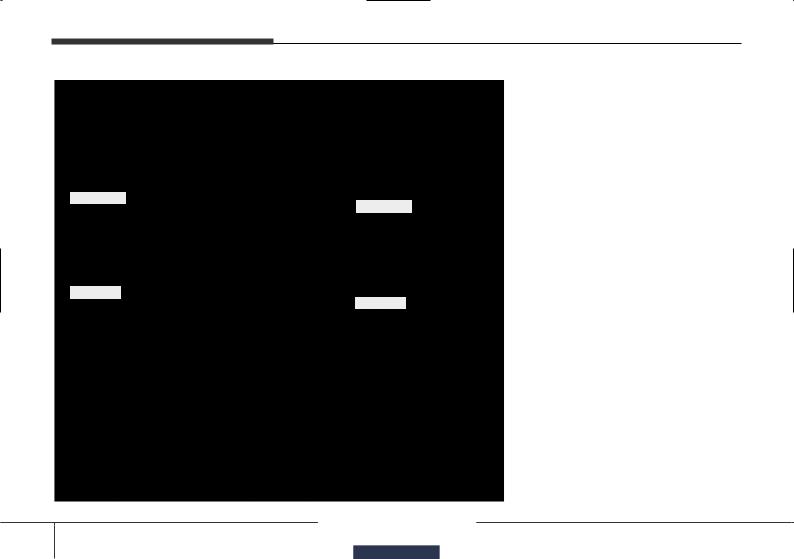
Safety features of your vehicle
SEATS
Manual seat
Manual seat
Power seat
Power seat
Front seat
(1)Forward and backward
(2)Seatback angle
(3)Seat cushion height (Driver’s seat)
(4)Lumbar support (Driver’s seat)*
(5)Seat warmer* /
ventilationSeatseat)*cooler
(6) Headrest
2nd row seat
(7)Forward and backward*
(8)Seatback angle and folding
(9)Headrest
(10)Armrest
(11)Seat warmer*
3rd row seat*
(12)Seatback folding
(13)Headrest
* if equipped
OXMA033001
3 2
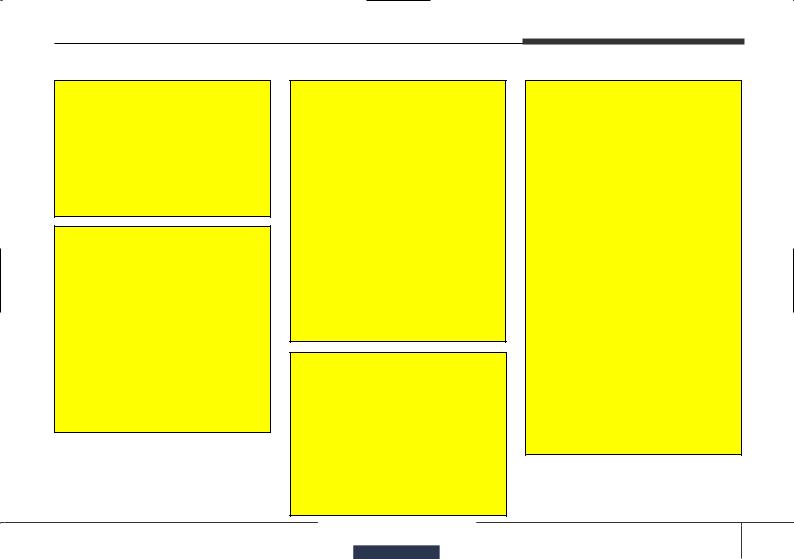
 WARNING - Loose objects
WARNING - Loose objects
Loose objects in the driver’s foot area could interfere with the operation of the foot pedals, possibly causing an accident. Do not place anything under the front seats.
 WARNING - Uprighting seat
WARNING - Uprighting seat
When you return the seatback to its upright position, hold the seatback and return it slowly and be sure there are no other passengers around the seat. If the seatback is returned without being held and controlled, the back of the seat could spring forward resulting in accidental injury to a person struck by the seatback.
 WARNING - Driver responsibility for front seat passenger
WARNING - Driver responsibility for front seat passenger
Riding in a vehicle with a front seatback reclined could lead to serious or fatal injury in an accident. If a front seat is reclined during an accident, the occupant’s hips may slide under the lap portion of the seat belt, applying great force to the unprotected abdomen. Serious or fatal internal injuries could result. The driver must advise the front passenger to keep the seatback in an upright position whenever the vehicle is in motion.
 WARNING
WARNING
Do not use a sitting cushion that reduces friction between the seat and passenger. The passenger’s hips may slide under the lap portion of the seat belt during an accident or a sudden stop. Serious or fatal internal injuries could result because the seat belt cannot operate normally.
Safety features of your vehicle
 WARNING - Driver’s seat
WARNING - Driver’s seat
•Never attempt to adjust the seat while the vehicle is moving. This could result in loss of control, and an accident causing death, serious injury, or property damage.
•Do not allow anything to interfere with the normal position of the seatback. Storing items against a seatback or in any other way interfering with proper locking of a seatback could result in serious or fatal injury in a sudden stop or collision.
•Always drive and ride with your seatback upright and the lap portion of the seat belt snug and low across the hips. This is the best position to protect you in case of an accident.
(Continued)
3 3
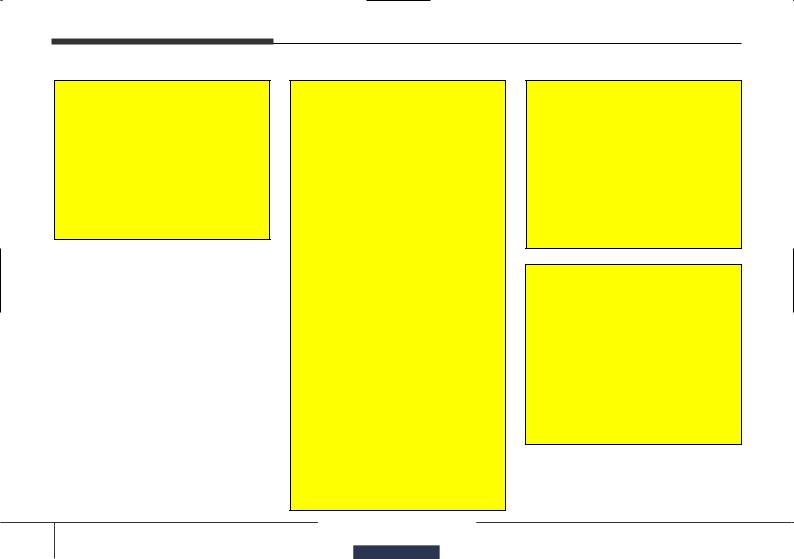
Safety features of your vehicle
(Continued)
•In order to avoid unnecessary and perhaps severe air bag injuries, always sit as far back as possible from the steering wheel while maintaining comfortable control of the vehicle. We recommend that your chest be at least 25 cm (10 inches) away from the steering wheel.
 WARNING - Rear seatbacks
WARNING - Rear seatbacks
•The rear seatback must be securely latched. If not, passengers and objects could be thrown forward resulting in serious injury or death in the event of a sudden stop or collision.
•Luggage and other cargo should be laid flat in the cargo area. If objects are large, heavy, or must be piled, they must be secured. Under no circumstances should cargo be piled higher than the seatbacks. Failure to follow these warnings could result in serious injury or death in the event of a sudden stop, collision or rollover.
•No passenger should ride in the cargo area or sit or lie on folded seatbacks while the vehicle is moving. All passengers must be properly seated in seats and restrained properly while riding.
(Continued)
(Continued)
•When resetting the seatback to the upright position, make sure it is securely latched by pushing it forward and backwards.
•To avoid the possibility of burns, do not remove the carpet in the cargo area. Emission control devices beneath this floor generate high temperatures.
 WARNING
WARNING
After adjusting the seat, always check that it is securely locked into place by attempting to move the seat forward or backward without using the lock release lever. Sudden or unexpected movement of the driver's seat could cause you to lose control of the vehicle resulting in an accident.
3 4

 WARNING
WARNING
•Do not adjust the seat while wearing seat belts. Moving the seat cushion forward may cause strong pressure on the abdomen.
•Use extreme caution so that hands or other objects are not caught in the seat mechanisms while the seat is moving.
•Do not put a cigarette lighter on the floor or seat. When you operate the seat, gas may gush out of the lighter and cause fire.
Safety features of your vehicle
Front seat adjustment - manual Seatback angle
Forward and backward
OXM039002
To move the seat forward or backward:
1.Pull the seat slide adjustment lever up and hold it.
2.Slide the seat to the position you desire.
3.Release the lever and make sure the seat is locked in place.
Adjust the seat before driving, and make sure the seat is locked securely by trying to move forward and backward without using the lever. If the seat moves, it is not locked properly.
OXM039003
To recline the seatback:
1.Lean forward slightly and lift up the seatback recline lever.
2.Carefully lean back on the seat and adjust the seatback of the seat to the position you desire.
3.Release the lever and make sure the seatback is locked in place. (The lever MUST return to its original position for the seatback to lock.)
3 5

Safety features of your vehicle
Seat height (for driver’s seat)
OXM039004
To change the height of the seat, push the lever upwards or downwards.
•To lower the seat cushion, push the lever down several times.
•To raise the seat cushion, pull the lever up several times.
Lumbar support (if equipped)
OXM033018
The lumbar support can be adjusted by pressing the lumbar support switch on the side of the seat.
1.Press the front portion of the switch to increase support, or the rear portion of the switch, to decrease support.
2.Release the switch once it reaches the desired position.
Front seat adjustment - power (if equipped)
The front seat can be adjusted by using the control switches located on the outside of the seat cushion. Before driving, adjust the seat to the proper position so you can easily control the steering wheel, pedals and switches on the instrument panel.
 WARNING
WARNING
The power seat is operable with the ignition OFF.
Therefore, children should never be left unattended in the vehicle.
3 6

 CAUTION
CAUTION
•The power seat is driven by an electric motor. Stop operating once the adjustment is completed. Excessive operation may damage the electrical equipment.
•When in operation, the power seat consumes a large amount of electrical power. To prevent unnecessary charging system drain, don’t adjust the power seat longer than necessary while the engine is not running.
•Do not operate two or more power seat control switches at the same time. Doing so may result in power seat motor or electrical component malfunction.
Safety features of your vehicle
Forward and backward |
Seatback angle |
OXM039006
Push the control switch forward or backward to move the seat to the desired position. Release the switch once the seat reaches the desired position.
OXM039007
Push the control switch forward or backward to move the seatback to the desired angle. Release the switch once the seat reaches the desired position.
3 7

Safety features of your vehicle
Seat height (for driver’s seat) |
Lumbar support (for driver’s seat) Driver position memory system |
|
(if equipped, for power seat) |
OXM039008
Pull the front portion of the control switch up to raise or press down to lower the front part of the seat cushion. Pull the rear portion of the control switch up to raise or press down to lower the rear part of the seat cushion. Release the switch once the seat reaches the desired position.
OXM039009
The lumbar support can be adjusted by pressing the button.
OXM033002
A driver position memory system is provided to store and recall the driver seat and outside rearview mirror position with a simple button operation. By saving the desired position into the system memory, different drivers can reposition the driver seat based upon their driving preference. If the battery is disconnected, the desired seat position memory will need to be re-saved.
3 8
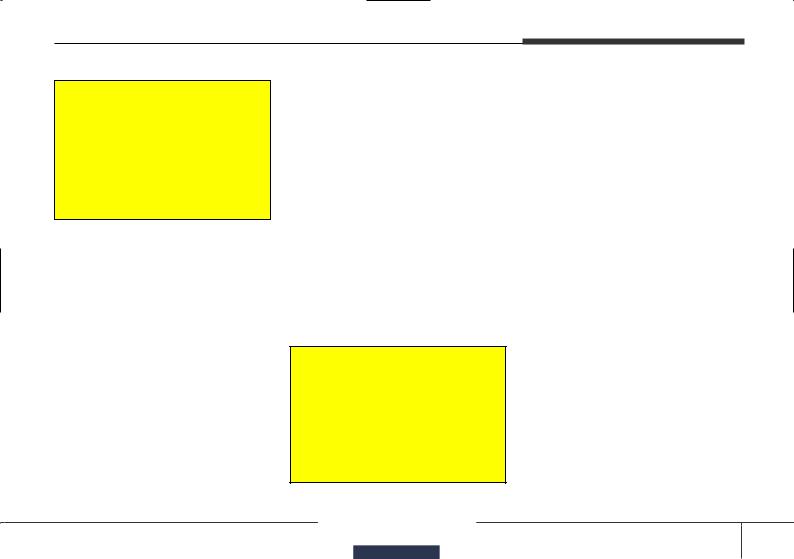
 WARNING
WARNING
Never attempt to operate the driver position memory system while the vehicle is moving.
This could result in loss of control, and an accident causing death, serious injury, or property damage.
Safety features of your vehicle
Storing positions into memory using the buttons on the door
Storing driver’s seat positions
1.Shift the shift lever into P (for Automatic transaxle) while the engine start/stop button is ON or ignition switch ON.
2.Adjust the driver’s seat and outside rearview mirror comfortable for the driver.
3.Press SET button on the control panel. The system will beep once.
4.Press one of the memory buttons (1 or 2) within 5 seconds after pressing the SET button. The system will beep twice when memory has been successfully stored.
 WARNING
WARNING
Use caution when recalling the adjustment memory while sitting in the vehicle. Push the seat position control switch to the desired position immediately if the seat moves too far in any direction.
Recalling positions from memory
1.Shift the shift lever into P (for Automatic transaxle) while the engine start/stop button is ON or ignition switch ON.
2.To recall the position in the memory, press the desired memory button (1 or 2). The system will beep once, then the driver’s seat will automatically adjust to the stored position.
Adjusting the control switch for the driver’s seat while the system is recalling the stored position will cause the movement to stop and move in the direction that the control switch is moved.
3 9

Safety features of your vehicle
Easy access function (if equipped)
The system will move the driver's seat automatically as follows:
•Without smart key system
-It will move the driver’s seat rearward when the ignition key is removed.
-It will move the driver’s seat forward when the ignition key is inserted.
•With smart key system
-It will move the driver’s seat rearward when the engine start/stop button is changed to the OFF position.
-It will move the driver’s seat forward when the engine start/stop button is changed to the ACC or START position.
You can activate or deactivate this feature. Refer to "User settings" in chapter 4.
Headrest (for front seat)
OHM038048N
The driver's and front passenger's seats are equipped with a headrest for the occupant's safety and comfort.
The headrest not only provides comfort for the driver and front passenger, but also helps protect the head and neck in the event of a rear collision.
 WARNING
WARNING
•For maximum effectiveness in case of an accident, the headrest should be adjusted so the middle of the headrest is at the same height of the center of gravity of an occupant's head. Generally, the center of gravity of most people's head is similar with the height of the top of their eyes. Also, adjust the headrest as close to your head as possible. For this reason, the use of a cushion that holds the body away from the seatback is not recommended.
•Do not operate the vehicle with the headrests removed. Severe injury to the occupants may occur in the event of an accident. Headrests may provide protection against neck injuries when properly adjusted.
•Do not adjust the headrest position of the driver’s seat while the vehicle is in motion.
3 10

OXM039011
Adjusting the height up and down
To raise the headrest, pull it up to the desired position (1). To lower the headrest, push and hold the release button (2) on the headrest support and lower the headrest to the desired position (3).
Safety features of your vehicle
 CAUTION
CAUTION
Excessive pulling or pushing may damage the headrest.
OXM039010
Adjusting the angle (if equipped)
The headrest angle may be adjusted by pulling or pushing the lower part of the headrest.
Adjust the headrest so that it properly supports the head and neck.
3 11
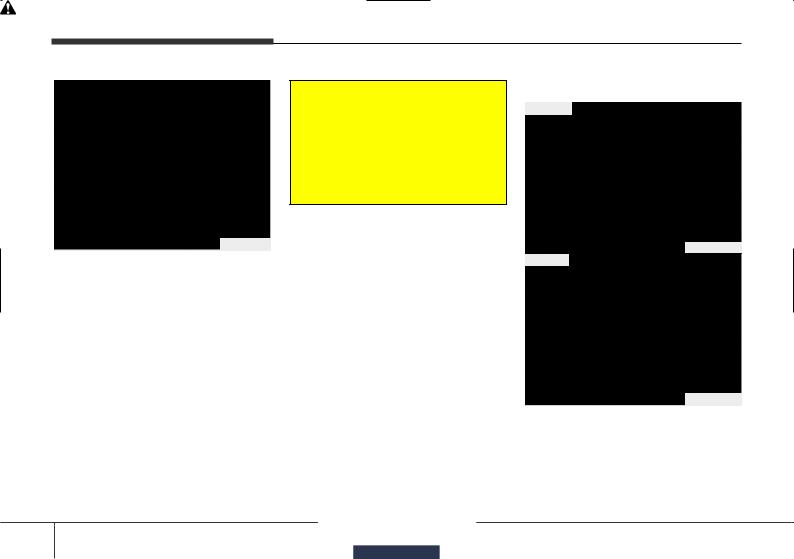
Safety features of your vehicle
Seat warmer (if equipped)
WARNING
■ Type A
A gap between the seat and the headrest release button may appear when sitting on the seat or when you push or pull the seat. Be careful not to get your finger, etc. caught in the gap.
HNF2041-1
Active headrest
The active headrest is designed to move forward and upward during a rear impact. This helps prevent the driver's and front passenger’s heads from moving backward and thus helps minimize neck injuries.
For your safety, the active headrest can’t be removed. If there is any problem with the active headrest, take your vehicle to an authorized Kia dealer and have the system checked.
OXM033005
■ Type B
OXM033004
The seat warmer is provided to warm the front seats during cold weather. With the ignition switch in the ON position, push either of the switches to warm the driver's seat or the front passenger's seat.
3 12
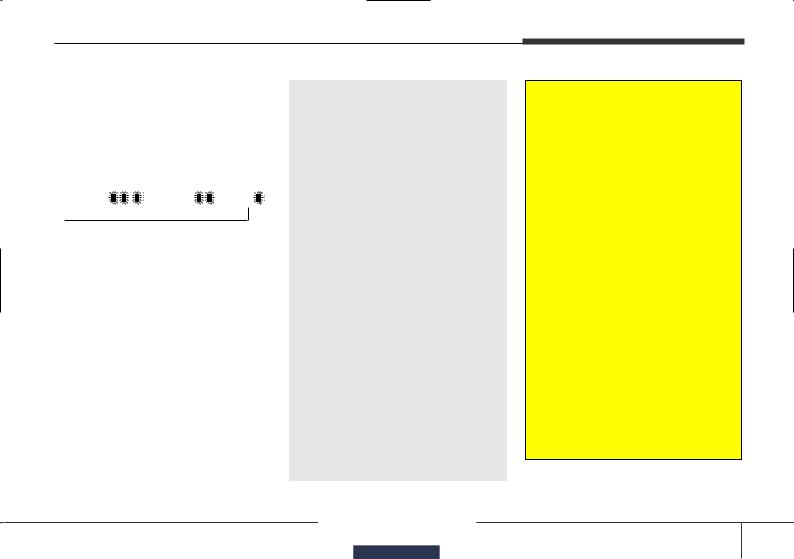
During mild weather or under conditions where the operation of the seat warmer is not needed, keep the switches in the "OFF" position.
•Each time you press the switch, the temperature setting of the seat will change as follows :
→ → OFF HIGH(→ |
) MIDDLE( ) LOW( ) |
→ |
|
•The seat warmer defaults to the OFF position whenever the ignition switch is turned on.
NOTICE
With the seat warmer switch in the ON position, the heating system in the seat turns off or on automatically depending on the seat temperature.
 CAUTION
CAUTION
•When cleaning the seats, do not use an organic solvent such as paint thinner, benzene, alcohol and gasoline. Doing so may damage the surface of the heater or seats.
•To prevent overheating the seat warmer, do not place anything on the seats that insulates against heat, such as blankets, cushions or seat covers while the seat warmer is in operation.
•Do not place heavy or sharp objects on seats equipped with seat warmers. Damage to the seat warming components could occur.
•Be careful not to spill liquid such as water or beverages on the seat. If you spill some liquid, wipe the seat with a dry towel. Before using the seat warmer, dry the seat completely.
Safety features of your vehicle
 WARNING - Seat warmer burns
WARNING - Seat warmer burns
Passengers should use extreme caution when using seat warmers due to the possibility of excess heating or burns. The seat warmer may cause burns even at low temperatures, especially if used for long periods of time. In particular, the driver must exercise extreme care for the following types of passengers:
1.Infants, children, elderly or handicapped persons, or hospital outpatients
2.Persons with sensitive skin or those that burn easily
3.Fatigued individuals
4.Intoxicated individuals
5.Individuals taking medication that can cause drowsiness or sleepiness (sleeping pills, cold tablets, etc.)
3 13
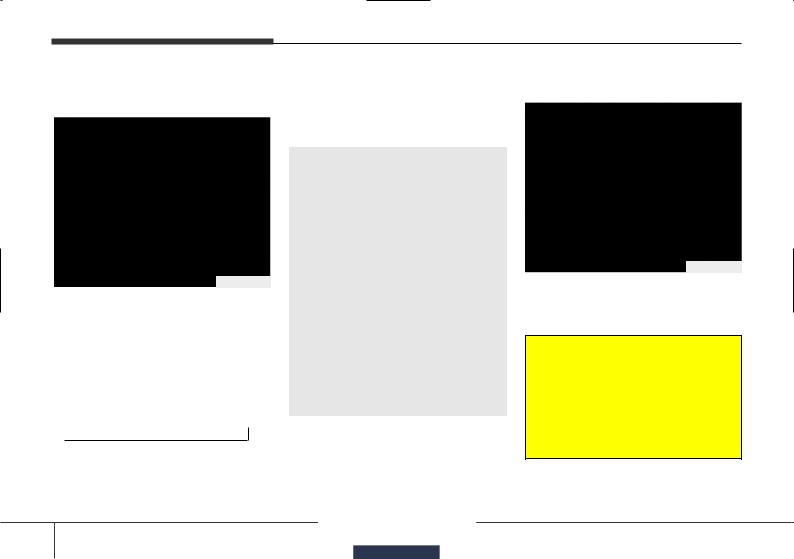
Safety features of your vehicle
Seat cooler (Air ventilation seat) (if equipped)
OXM033003
The temperature setting of the seat changes according to the switch position.
•If you want to cool your seat cushion, press the switch (blue color).
•Each time you press the button, the airflow will change as follows:
→ → OFF HIGH(→ 

 ) MIDDLE(
) MIDDLE( 
 ) LOW(
) LOW(  )
)
→
•The seat warmer (with air ventilation) defaults to the OFF position whenever the ignition switch is turned on.
 CAUTION - Seat damage
CAUTION - Seat damage
•When cleaning the seats, do not use an organic solvent such as paint thinner, benzene, alcohol and gasoline. Doing so may damage the air ventilation seat.
•Do not place heavy or sharp objects on the seat. Those things may damage the air ventilation seat.
•Be careful not to spill liquid such as water or beverages on the seat. If you spill some liquid, wipe the seat with a dry towel. Before using the air ventilation seat, dry the seat completely.
Seatback pocket
ORP032013
The seatback pocket is provided on the back of the front passenger’s and driver’s seatbacks.
 WARNING - Seatback pockets
WARNING - Seatback pockets
Do not put heavy or sharp objects in the seatback pockets. In an accident they could come loose from the pocket and injure vehicle occupants.
3 14

|
|
Safety features of your vehicle |
|
|
|
Rear seat adjustment |
Seatback angle (2nd row seat) |
Walk-in seat |
Forward and backward |
|
(2nd row seat, if equipped) |
|
|
|
(2nd row seat) |
|
|
OXMA033103
To move the seat forward or backward:
1.Pull the seat slide adjustment lever up and hold it.
2.Slide the seat to the position you desire.
3.Release the lever and make sure the seat is locked in place.
Adjust the seat before driving, and make sure the seat is locked securely by trying to move forward and backward without using the lever. If the seat moves, it is not locked properly.
OXMA033104
To recline the seatback:
1.Pull up the seatback recline lever.
2.Hold the lever and adjust the seatback of the seat to the position you desire.
3.Release the lever and make sure the seatback is locked in place. (The lever MUST return to its original position for the seatback to lock.)
OXM039031
OXMA033105
To get in or out of the 3rd row seat,
1.Route the seat belt webbing through the rear seat belt guide clip. After inserting the seat belt, tighten the belt webbing by pulling it up.
2.Pull up the walk-in lever (1) on the 2nd row seatback.
3 15
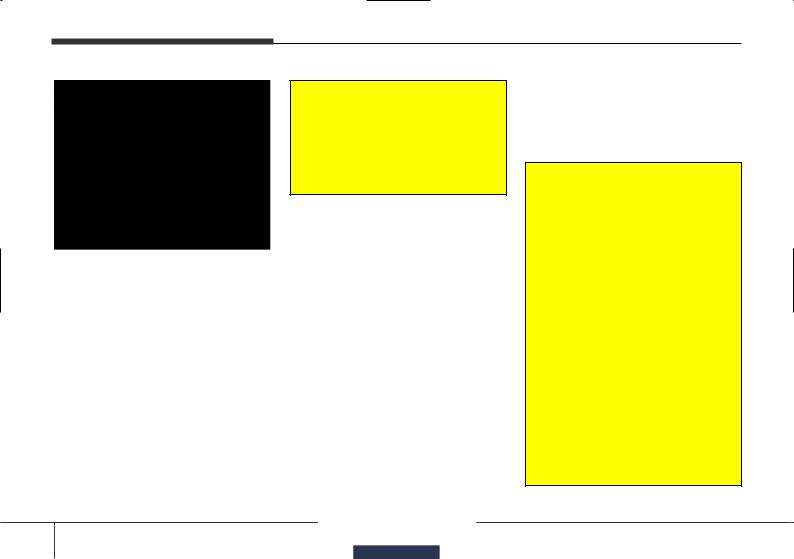
Safety features of your vehicle
OXMA033106
3.Fold the 2nd row seatback and push the seat to the farthest forward position.
After getting in or out, slide the 2nd row seat to the farthest rearward position and pull the seatback firmly backward until it clicks into place. Make sure that the seat is locked in place.
 WARNING
WARNING
Never attempt to adjust the 2nd row seat while the vehicle is moving or the seat is occupied as the seat may suddenly move and cause the passenger on the seat to be injured.
Folding the rear seat
The rear seatbacks can be folded to facilitate carrying long items or to increase the luggage capacity of the vehicle.
 WARNING
WARNING
The purpose of the fold-down rear seatbacks is to allow you to carry longer objects that could not be accommodated in the cargo area.
Never allow passengers to sit on top of the folded down seatback while the vehicle is moving. This is not a proper seating position and no seat belts are available for use. This could result in serious injury or death in case of an accident or sudden stop. Objects carried on the folded down seatback should not extend higher than the top of the front seatbacks. This could allow cargo to slide forward and cause injury or damage during sudden stops.
3 16
